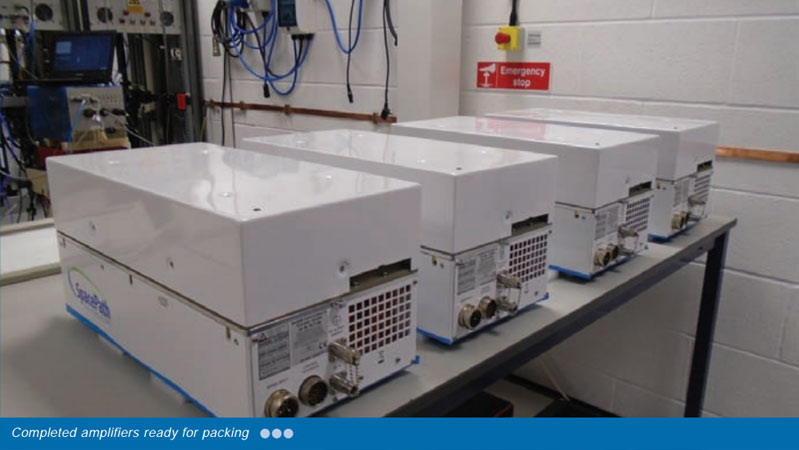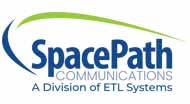
SpacePath Communications was founded in the UK in 2014 to design, manufacture and deliver satellite uplink amplifiers to a global customer base. Its portfolio includes indoor and outdoor products, travelling wave tube amplifiers (TWTAs) and solid state power amplifiers (SSPAs), using both GaAs and GaN technologies. Amy Saunders met with SpacePath Directors Colin Bolton and Newton Burnet at their headquarters in Hook, UK, to find out more about the company’s achievements in the last three years and its plans for future growth.
SpacePath was founded in 2014, but it was far from a standing start. Directors Colin Bolton and Newton Burnet explained that they often refer to the company as ‘a 40-year start-up’ thanks to their extensive experience in the satellite amplifier field, as well as the immediate acquisition of the Stellar Satcom satellite uplink product range from e2v Technologies. The motivation to form their own start-up was attributed to the advantages provided by operating within a small company compared with the large enterprises. “We’d both been employed in larger companies previously, and we knew some of the problems associated with those. We felt that to start a European-based amplifier manufacturing company, taking full advantage of the versatility and responsiveness associated with a small independent company, would be a very powerful way to grow the business, and we’d have the added advantage of being unique within Europe,” commented Burnet.
“We had to be different from the others, and we believe that our size, agility and speed are of paramount importance in our business,” continued Bolton. The acquisition of Stellar Satcom immediately provided SpacePath with a wide, international customer base. “The minute we acquired the business, we were also obligated for every support activity as well as part of that process, which was challenging,” added Bolton. SpacePath moved into its facility at Hook three years ago, when it was an empty shell. Improvements have gradually been added, including a lab area, storage facilities and offices. Bolton commented: “It’s an on-going process; good, clean environments don’t just happen overnight!” The facility is ideally located 45 minutes away from Heathrow Airport, and has an excellent pool of highly-skilled new talent to draw on from nearby educational institutions. There is also plenty of room for expansion, which is key to the company’s future. Unlike many of the larger amplifier companies, SpacePath works with several specialist sub-contractors to build the power supply sub-assemblies to its own designs, which allows the company to operate its facility with fewer production people than would normally be required. The flexibility to vary the supply as required is extremely beneficial. Travelling wave tubes are among the other components that are delivered to the lab area on the ground floor of the facility, where SpacePath engineers assemble, burn-in and fully test every amplifier.
Building out a product portfolio
SpacePath has come a long way since its founding just three years ago. At the time, the company was limited to a small range of outdoor amplifiers, with no indoor amplifier products in its portfolio at all. “When we started the company, we didn’t have a range of indoor amplifiers mainly used in fixed Earth station applications, and there was nothing that would stand up to today’s competition or customer expectations,” said Bolton.
Bolton and Burnet have duly spent the last three years innovating and expanding their portfolio. Around 18 months ago, the company started work on a range of indoor uplink amplifiers, primarily for fixed Earth station applications, all with full-feature touch screen integration panels. Today, SpacePath’s portfolio contains a wide array of amplifier products that span different frequencies and power outputs, in addition to sub-systems and controllers. The company continues to develop new solutions for indoor and outdoor TWTAs and SSPAs, which are becoming more efficient and more powerful.
For SSPAs, SpacePath uses both GaN and GaAs technologies. “When it comes to GaN vs GaAs, there’s no one-size-fits-all, it depends on the frequency and power,” stated Bolton. Much of SpacePath’s work with SSPAs is achieved with a non-UK partner company on both the development and sales sides, while support and product testing is completed on-site at Hook. According to Bolton, SSPAs are becoming an increasingly important part of the business as demand for lower power applications grows. The company is currently concentrating on the holes in its product range, with Ka-band being the biggest priority, particularly for the high-power end of the market. According to Bolton, manufacturing Ka-band devices comes with its own set of challenges. The amplifiers operate at much higher voltages, the power supply needs to be very robust, and the control systems must be capable of controlling the power supplies extremely rapidly, since the travelling wave tubes are so much more expensive than lower band tubes, and much more easily damaged by voltage anomalies.
“Ka-band is very much underway, but those products are quite different from others to manufacture; Ka-band and beyond requires meticulous design, tight control on assembly and testing, but we’re pretty much there in having our first products ready at the engineering stage,” said Bolton.
Burnet described the company’s new 500W Ka-band amplifier, which is available as both standard air-cooled and liquid-cooled iterations for different outside applications. “A lot of these amplifiers get used out in the desert, where traditional fans and heatsinks require more maintenance. Water free-flowing from a chiller means that there’s hardly any maintenance to consider,” added Burnet.
In addition to Ka-band, SpacePath’s latest power supply design is also able to power the Q and V-band amplifiers of the future, although the challenges described in manufacturing Ka-band products are amplified for Q and Vband, while the travelling wave tubes are even more expensive and much more limited in supply. SpacePath isn’t diving into Q and V-band amplifiers just yet: “It’s very much an unravelling story,” said Bolton. The company plans to wait to see how customer demand for such devices develops in the coming months and years. “We’re looking at what the tube manufacturers are doing on the TWT side. Ground-based developments come out of the space segment technology, whatever they’re using in space in terms of technology, will ultimately come down to the ground,” said Bolton.
Unlike many of its competitors, SpacePath’s amplifiers have been designed in a very modular way, which enables easier long-term maintenance. While parts don’t usually need replacing during the equipment’s lifetime, customers want to know that if something does go wrong in a high-profile environment, they can have access to all the parts for immediate on-site replacement. The same power supply can be used for C, Ku, and DBS-bands, which makes it easier for customers to stock a standard set of parts for all their amplifiers.

Marketing to the world
SpacePath is truly a global company, servicing customers from all over the world.
“As far as the spread goes, it’s really across the board. Europe is, of course, a big market for us, but the USA also represents a big potential market. Going forwards, we have a joint venture in the USA called Stellar Satcom, and that potentially represents a big market for us,” said Bolton. “We’re mindful that we have to develop in other areas as well, and we’ve made a conscious decision that we need to participate more. We participated at Convergence India recently, where the potential for satcom is very big. It’s a challenging market, but we’ve appointed a very good partner in India, and we’ve already won several contracts. In the Middle East, we have established a customer service centre based in the UAE and for the Asia-Pacific markets, we have appointed a number of sales and service partners across the region. South America is an area that we’ve yet to penetrate,” said Bolton.
Broadcast has been one of the initial key areas of focus for SpacePath, deploying upgraded product designs originally acquired from the e2v “Stellar” amplifier product range acquisition. SpacePath is well-placed to serve those customers, being able to react quickly. Broadcast DSNG, fixed teleport and on-the-move applications are currently SpacePath’s key clientele.
However, the broadcast market has faced major disruption in recent years, with the key challenges coming from other technologies. “Today we’ve got 4G bonding equipment, which is very low cost and enables people to achieve quick inserts, and has taken away from some of the traditional satellite uplink business,” Bolton explained. “Fibre, too, represents a challenge, and has also taken away from the satellite business. On the technology side, the increase in the power and frequency capabilities in GaN technology will make a major difference in the future, and SpacePath maintains that it will embrace this technology, through the roll-out of new product offerings,” continued Bolton.
Military satellite communications and communications on the move (COTM) are two areas that go well together, but the company hasn’t pushed hard into the latter market yet. “We’ve had a limited number of resources up to now, but clearly, as a UK-based manufacturer, that would represent quite an interest, as there’s not many other companies doing what we do,” explained Bolton. “We’ve started to make inroads, talking to the major companies in the milsatcom market, but it’s early days for the development of that business.”
SpacePath’s business model is different to many others in the market, and with its flexible manufacturing approach, its costs and overheads remain low. Creating bespoke hardware and software products to customer requirements is a key part if its business. “Listening to customers is key to our business, and sets us apart from some of our competitors. The bigger you grow, the harder it is to react speedily and make anything non-standard,” added Bolton.
The company’s small size also means that turnaround times can be very short. While a standard turnaround for repairs is two weeks, work can often be completed within days. “We still get people who call us and request support within a few hours, and we try, where possible, to accommodate that. The broadcast business is notorious for that,” said Burnet.
Being based in the UK, SpacePath is considered a local company in Europe, which has major advantages for transporting products. “We also don’t have any customs issues (for now), so that really works to our advantage,” outlined Bolton. “We can get new equipment and spare parts to Europe within a day, whereas across the Atlantic, you’re looking at around a week,” added Burnet.

A changing landscape
SpacePath completed its first three years of operations in March 2017, and it’s been a fantastic time for the company. “Looking at our first three years of business, the mix has been completely different to what we anticipated, but the volumes and results are on course, which we’re pleased about,” said Bolton.
April 2017 marks the start of SpacePath’s fourth year of operations, and it’s likely to be busier than ever before. Bolton and Burnet are looking forward to a year participating in key industry events following on from Convergence India, Satellite 2017, and CABSAT; NAB Show, CommunicAsia, and IBC. Making as many meetings as possible with new and existing customers at these events is key to SpacePath’s growth strategy. “We’re attempting to punch above our weight, in terms of our size,” said Bolton. “We want to reach as many customers as we can, geographically.”
There’s a lot of new opportunities on the horizon for SpacePath, with high throughput satellites, LEO and MEO constellations all offering new, diverse markets in need of amplifiers. “HTS provides us with excellent opportunities for selling high powered Ka-band devices for gateway applications, so that’s good for us,” explained Bolton. “The LEOs and MEOs, will have an impact on our lower powered solid state amplifiers.”
Bolton and Burnet expect a great deal of change in the coming years, emphasising the need to adapt to both new technologies and new ways of doing business. “We have to learn to adapt quickly to the changes, to offer products that new customers require,” added Bolton. “It’s quite evident that the landscape is changing.”

